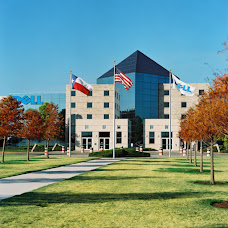In computer networking and telecommunications, Multi Protocol Label Switching (MPLS) is a data-carrying mechanism that belongs to the family of packet-switched networks. MPLS operates at an OSI Model layer that is generally considered to lie between traditional definitions of Layer 2 (data link layer) and Layer 3 (network layer), and thus is often referred to as a "Layer 2.5" protocol.
It was designed to provide a unified data-carrying service for both circuit-based clients and packet-switching clients which provide a datagram service model. It can be used to carry many different kinds of traffic, including IP packets, as well as native ATM, SONET, and Ethernet frames.
A number of different technologies were previously deployed with essentially identical goals, such as frame relay and ATM. MPLS is now replacing these technologies in the marketplace, mostly because it is better aligned with current and future technology needs.
In particular, MPLS dispenses with the cell-switching and signaling-protocol baggage of ATM. MPLS recognizes that small ATM cells are not needed in the core of modern networks, since modern optical networks (as of 2001) are so fast (at 10 Gbit/s and well beyond) that even full-length 1500 byte packets do not incur significant real-time queuing delays (the need to reduce such delays — e.g., to support voice traffic — was the motivation for the cell nature of ATM).
At the same time, MPLS attempts to preserve the traffic engineering and out-of-band control that made frame relay and ATM attractive for deploying large-scale networks.
MPLS was originally proposed by a group of engineers from Ipsilon Networks, but their "IP Switching" technology, which was defined only to work over ATM, did not achieve market dominance. Cisco Systems, Inc. introduced a related proposal, not restricted to ATM transmission, called "Tag Switching" when it was a Cisco proprietary proposal, and was renamed "Label Switching" when it was handed over to the IETF for open standardization. The IETF work involved proposals from other vendors, and development of a consensus protocol that combined features from several vendors' work.
One original motivation was to allow the creation of simple high-speed switches, since for a significant length of time it was impossible to forward IP packets entirely in hardware. However, advances in VLSI have made such devices possible. Therefore the advantages of MPLS primarily revolve around the ability to support multiple service models and perform traffic management. MPLS also offers a robust recovery frameworkthat goes beyond the simple protection rings of synchronous optical networking (SONET/SDH).
While the traffic management benefits of migrating to MPLS are quite valuable (better reliability, increased performance), there is a significant loss of visibility and access into the MPLS cloud for IT departments.
How MPLS works
MPLS works by prefixing packets with an MPLS header, containing one or more 'labels'. This is called a label stack.
Each label stack entry contains four fields:
a 20-bit label value.
a 3-bit field for QoS (Quality of Service) priority (experimental).
a 1-bit bottom of stack flag. If this is set, it signifies that the current label is the last in the stack.
an 8-bit TTL (time to live) field.
These MPLS-labeled packets are switched after a Label Lookup/Switch instead of a lookup into the IP table. As mentioned above, when MPLS was conceived, Label Lookup and Label Switching were faster than a RIB lookup because they could take place directly within the switched fabric and not the CPU.
The entry and exit points of an MPLS network are called Label Edge Routers (LER), which, respectively, push an MPLS label onto the incoming packet and pop it off the outgoing packet. Routers that perform routing based only on the label are called Label Switch Routers (LSR). In some applications, the packet presented to the LER already may have a label, so that the new LSR pushes a second label onto the packet. For more information see Penultimate Hop Popping.
Labels are distributed between LERs and LSRs using the “Label Distribution Protocol” (LDP). Label Switch Routers in an MPLS network regularly exchange label and reachability information with each other using standardized procedures in order to build a complete picture of the network they can then use to forward packets. Label Switch Paths (LSPs) are established by the network operator for a variety of purposes, such as to create network-based IP Virtual Private Networks or to route traffic along specified paths through the network. In many respects, LSPs are no different than PVCs in ATM or Frame Relay networks, except that they are not dependent on a particular Layer 2 technology.
In the specific context of an MPLS-based Virtual Private Network (VPN), LSRs that function as ingress and/or egress routers to the VPN are often called PE (Provider Edge) routers. Devices that function only as transit routers are similarly called P (Provider) routers. See RFC 2547. The job of a P router is significantly easier than that of a PE router, so they can be less complex and may be more dependable because of this.
When an unlabeled packet enters the ingress router and needs to be passed on to an MPLS tunnel, the router first determines the forwarding equivalence class (FEC) the packet should be in, and then inserts one or more labels in the packet's newly-created MPLS header. The packet is then passed on to the next hop router for this tunnel.
When a labeled packet is received by an MPLS router, the topmost label is examined. Based on the contents of the label a swap, push (impose) or pop (dispose) operation can be performed on the packet's label stack. Routers can have prebuilt lookup tables that tell them which kind of operation to do based on the topmost label of the incoming packet so they can process the packet very quickly.
In a swap operation the label is swapped with a new label, and the packet is forwarded along the path associated with the new label.
In a push operation a new label is pushed on top of the existing label, effectively "encapsulating" the packet in another layer of MPLS. This allows hierarchical routing of MPLS packets. Notably, this is used by MPLS VPNs.
In a pop operation the label is removed from the packet, which may reveal an inner label below. This process is called "decapsulation". If the popped label was the last on the label stack, the packet "leaves" the MPLS tunnel. This is usually done by the egress router, but see PHP below.
During these operations, the contents of the packet below the MPLS Label stack are not examined. Indeed transit routers typically need only to examine the topmost label on the stack. The forwarding of the packet is done based on the contents of the labels, which allows "protocol-independent packet forwarding" that does not need to look at a protocol-dependent routing table and avoids the expensive IP longest prefix match at each hop.
At the egress router, when the last label has been popped, only the payload remains. This can be an IP packet, or any of a number of other kinds of payload packet. The egress router must therefore have routing information for the packet's payload, since it must forward it without the help of label lookup tables. An MPLS transit router has no such requirement.
In some special cases, the last label can also be popped off at the penultimate hop (the hop before the egress router). This is called Penultimate Hop Popping (PHP). This may be interesting in cases where the egress router has lots of packets leaving MPLS tunnels, and thus spends inordinate amounts of CPU time on this. By using PHP, transit routers connected directly to this egress router effectively offload it, by popping the last label themselves.
MPLS can make use of existing ATM network infrastructure, as its labeled flows can be mapped to ATM virtual circuit identifiers, and vice versa.
Comparison of MPLS versus IP
MPLS cannot be compared to IP as a separate entity because it works in conjunction with IP and IP's IGP routing protocols. MPLS gives IP networks simple traffic engineering, the ability to transport Layer 3 (IP) VPNs with overlapping address spaces, and support for Layer 2 pseudowires (with Any Transport Over MPLS, or ATOM - see Martini draft). Routers with programmable CPUs and without TCAM/CAM or another method for fast lookups may also see a limited increase in the performance.
MPLS relies on IGP routing protocols to construct its label forwarding table, and the scope of any IGP is usually restricted to a single carrier for stability and policy reasons. As there is still no standard for carrier-carrier MPLS it is not possible to have the same MPLS service (Layer2 or Layer3 VPN) covering more than one operator.
Comparison of MPLS versus Frame Relay
Frame relay aimed to make more efficient use of existing physical resources, which allow for the underprovisioning of data services by telecommunications companies (telcos) to their customers, as clients were unlikely to be utilizing a data service 100 percent of the time. In more recent years, frame relay has acquired a bad reputation in some markets because of excessive bandwidth overbooking by these telcos.
Telcos often sell frame relay to businesses looking for a cheaper alternative to dedicated lines; its use in different geographic areas depended greatly on governmental and telecommunication companies' policies. Some of the early companies to make frame relay products included StrataCom (later acquired by Cisco Systems) and Cascade Communications (later acquired by Ascend Communications and then by Lucent Technologies).
AT&T is currently (as of June 2007) the largest frame relay service provider in the United States, with local networks in 22 states, plus national and international networks. This number is expected to change between 2007 and 2009 when most of these frame relay contracts expire. Many customers are likely to migrate from frame relay to MPLS over IP or Ethernet within the next two years, which in many cases will reduce costs and improve manageability and performance of their wide area networks.
MPLS deployment
MPLS is currently in use in large "IP Only" networks, and is standardized by IETF in RFC 3031.
In practice, MPLS is mainly used to forward IP datagrams and Ethernet traffic. Major applications of MPLS are Telecommunications traffic engineering and MPLS VPN.
Competitors to MPLS
MPLS can exist in both IPv4 environment (IPv4 routing protocols) and IPv6 environment (IPv6 routing protocols). The major goal of MPLS development - the increase of routing speed - is no longer relevant because of the usage of ASIC, TCAM and CAMbased switching. Therefore the major usage of MPLS is to implement limited traffic engineering and Layer 3/Layer 2 “service provider type” VPNs over existing IPv4 networks. The only competitors to MPLS are technologies like L2TPv3 that also provide services such as service provider Layer 2 and Layer 3 VPNs.
IEEE 1355 is a completely unrelated technology that does something similar in hardware.
IPv6 references: Grossetete, Patrick, IPv6 over MPLS, Cisco Systems 2001; Juniper Networks IPv6 and Infranets White Paper; Juniper Networks DoD's Research and Engineering Community White Paper.
Access to MPLS networks
MPLS supports a range of access technologies, including T1, ATM and frame relay. While less expensive DSL connections may also be used, they don’t allow network users to reap the significant MPLS benefit of class-of-service application prioritization. In January 2008, however, New Edge Networks announced plans to make traffic prioritization on its MPLS network available via DSL access. According to New Edge, its service will enable businesses to implement and manage an MPLS network without having to assume the higher price of T1 lines at all locations. The company said its MPLS class of service over DSL is scheduled for an April 2008 rollout.This is an industry first.[16] Normally, a company wanting to run MPLS would require T1 lines or better.
Benefits of MPLS
MPLS provides networks with a more efficient way to manage applications and move information between locations. With the convergence of voice, video and data applications, business networks face increasing traffic demands. MPLS enables class of service (CoS) tagging and prioritization of network traffic, so administrators may specify which applications should move across the network ahead of others.
This function makes an MPLS network especially important to firms that need to ensure the performance of low-latency applications such as VoIP and their other business-critical functions. MPLS carriers differ on the number of classes of service they offer and in how these CoS tiers are priced.
my notes about mpls.
Saturday, February 23, 2008
Subscribe to:
Post Comments (Atom)
beach

cottesloe beach restaurant
City of Perth

view from King's park
Houston TX

San antonio


















No comments:
Post a Comment